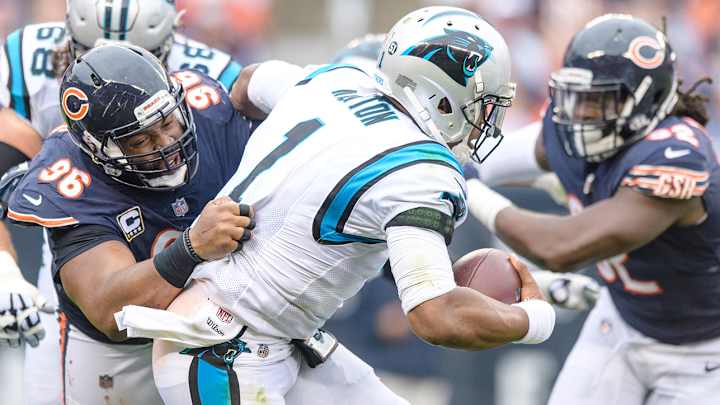The Bears Are Everything a Modern NFL Team Isn’t Supposed to Be . . . and They’re on a Winning Streak

Two weeks ago, the Bears lost a Monday nighter to the Vikings in Mitchell Trubisky’s NFL debut. If you were told they were about to win back-to-back games for the first time since November 2015, you’d assume that would mean Trubisky was becoming a Windy City folk hero. Though he’d looked expectedly “rookie-ish” in his NFL debut (including a late fourth-quarter interception), Trubisky teased the mobile playmaking prowess that made him the second overall pick of the draft. There was a decisiveness to his play. Optimism was in order.
And now, here they sit, 2-0 since that night. Except Trubisky has been almost a nonfactor. In last week’s win over Baltimore, he handed it off 50 times and the Bears rolled up 199 rushing yards. His 16 pass attempts were, he said, the lowest of any game in his life. Until Sunday that is, when he threw seven times against the Panthers. The Bears weren’t hiding Trubisky quite as much as they did against the Ravens; they happened to have only 37 snaps the entire game, thanks to a pair of defensive return touchdowns at the end of long Panthers drives. (Eddie Jackson scooped up a botched speed-option toss to Curtis Samuel and ran it back 75 yards. Later, Jackson caught a Prince Amukamara deflection against a patented Kelvin Benjamin slant and returned it 76 yards for a score.) Only 24 times since the merger has a team run 37 or fewer plays; this marks just the third time it was done in victory (joining Peyton Manning's Colts over the Dolphins in 2009, and Vince Young's Titans beating the Jaguars in '06).

So can the Bears continue to win this way? They’ll have to. Not only is Trubisky young and inexperienced, he has no wide receivers. In these two wins, Chicago’s starting wideouts have been third-year fringe backup Tre McBride, who’s been mostly used as a blocker (with so-so results) and undrafted rookie Tanner Gentry, who has been mostly nothing (zero targets vs. Carolina, one against Baltimore).
The Bears do have a sustaining ground game with zone-running maestro Jordan Howard, as well as a dynamic movable weapon in fourth-round rookie back Tarik Cohen. On Sunday, Cohen’s damage came as a wide receiver, both in the slot and from a tight split at wideout on his 70-yard bomb against cornerback Kevon Seymour. (It was on a straight seven-step dropback on first down, with no play-action—a surprising way for offensive coordinator Dowell Loggains to be aggressive with Trubisky.)
Howard and Cohen give the Bears just enough to keep breathing on offense, but any playoff push will stem from Chicago’s defense, which is better than people know. That was the case last year, too. The difference is now that defense is making plays. It’s a zone-based unit that often shows two deep safeties before the snap. This allows for subtle, effective coverage disguises, as the safeties are in perfect position to rotate after the snap. It also allows all defenders to keep eyes on the ball, as opposed to strictly on their man. It’s a perfect recipe for creating turnovers. Last season, the Bears, befuddlingly, did not. Their 11 forced turnovers tied with the 2015 Cowboys, 2013 Texans and 1982 Colts for fewest in a 16-game season. Seven games into this season they’ve forced nine turnovers, including six in their last two games, three of which were taken to the house. (Adrian Amos had a 90-yard pick-six against the Ravens). This is what the Brian Urlacher Bears used to do.
Packers Are In It Deep, Zeke Rolls, Steelers Are Dominant
This defense may not have an Urlacher type enforcer (or even a Lance Briggs or Charles Tillman type), but it’s talented nonetheless. Agile second-year edge rusher Leonard Floyd has bendability and great chase speed (Cam Newton found this out the hard way). Opposite him, Pernell McPhee, back from the knee injury that cost him seven games in 2016 and loads of practice reps, has flashed familiar burst and strength (even though his own coordinator, Vic Fangio, acknowledged that McPhee may never be the player he once was).
Between the edge men is one of the league’s most resolute defensive lines. Mitch Unrein is an unheralded clogger. Eddie Goldman sheds blocks and moves in short areas as well as almost anyone in the game—“almost” because no one in 2017 has been better than Akiem Hicks. The sixth-year pro deserves Defensive Player of the Year consideration.
In recent years, shoddy secondary play has outweighed Chicago’s output up front. Not anymore. With Amukamara settled in at right corner, Kyle Fuller has moved to the left side and looks like the player everyone expected him to become after his sensational rookie campaign in 2014. Besides being an impactful run supporter (critical in a two-deep safety scheme when it’s Cover 2), Fuller has shown keen timing and technique at the top of routes, including against bigger receivers along the sidelines. That was important several times against Carolina’s Benjamin and Devin Funchess. And, obviously, the Bears are getting big plays from their safeties. (And, for what it’s worth, Amos and Jackson have been stellar at rotating down to defend the flats—a less sexy but significant task in a coverage-rotating, two-deep scheme.)
The Bears are equipped to win by any means except the one that almost every team today relies on: throwing the ball. They’re the antithesis of a modern NFL squad. And, at least for two weeks, it has worked.
• Question or comment? Email us at talkback@themmqb.com.
